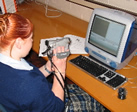Secondary 2
In this activity, Year 7 pupils used a multimedia CD-ROM as part of a sequence of lessons exploring the question: ‘Why is a church an important building for Christians?’ Following class discussions, the pupils identified five questions they most wanted to ask a visitor to their next lesson - a local Anglican priest - to help them to respond in an informed way to the question. The lesson took place in an ICT suite.
Using a digital projector to demonstrate the structure of the CD-ROM to the whole class, the teacher displayed a series of pre-selected screens, focusing on the parts that the pupils needed to access. The teacher:
demonstrated how to navigate the CD-ROM from its home page
prompted pupils to reflect on the content of the screens, drawing on prior learning and opening up new questions for investigation
demonstrated how sound files are accessed, and explained that sounds as well as images and text are a valuable source of information
pointed out the ‘test yourself’ sections which pupils would be asked to complete, and invited them to think about how this would affect the way they chose to interact with the CD-ROM.
Pupils had previously visited a church and appreciated how the design of the building reflects the main activities which take place there. As a result they had identified the celebration of the Mass and Eucharist as a significant event in Anglican and Roman Catholic places of worship.
Working in pairs, the pupils completed the self-contained multimedia sequence on the CD-ROM about the Mass/Eucharist as celebrated in an Anglican church. As well as viewing video clips and other visual stimuli, the students listened to sound files of the priest saying the words of the service, and took advantage of interactive opportunities to test their understanding. The visual material focused on the symbols of the rituals and the actions of the congregation and priest. The pupils recorded their responses on a sheet designed to support the activity, and discussed their responses as a class.
In the plenary, pupils again worked in pairs to identify the five questions they most wanted their visitor to answer to help them move towards an informed response to the lesson question.
During this activity, pupils:
investigated key features and symbols of an act of worship, drawing meaning from text, sound and images
made connections between events in the life of Jesus and the beliefs and practices of contemporary Christians
identified questions to ask a visitor to further their understanding.
How ICT enhanced teaching and learning
CD-ROMs make vast amounts of pre-selected content easily available. They present the information in an interactive and multi-sensory way. CD-ROMs motivate many pupils to engage in the learning process through, for example, high-quality images, animated explanations, spoken commentary, video clips, interactive activities to test understanding, and sound clips.
In this instance, the teacher used the first part of the lesson to demonstrate how the CD-ROM was organised, asking questions to prompt pupils to make links with their prior experience and learning. The teacher also encouraged the pupils to reflect on what they needed to find out from the CD-ROM in order to answer the key question.
All the pupils remained on task throughout the lesson and stayed in the section of the CD-ROM identified. They showed confidence in navigating the CD-ROM, and familiarity with the key ideas and vocabulary introduced in the first part of the lesson. This was helped by the audio and textual presentation of the information as well as the images contained within the CD-ROM. Working in pairs helped them to debate ideas together and identify probing questions to ask their visitor.
Commenting on the choice of the CD-ROM to meet the learning objectives, the teacher said:“Usually churches are empty when visited - pupils miss out a lot. The interactivity of the CD-ROM helps pupils feel they are sharing the experience of worship with a real congregation: a text book can never do this.”
Links and Resources
The REonline website has a list of CD-ROM resources
See also the ICTAC pack that can be found on the RE documents part of the MMI website downloads page

